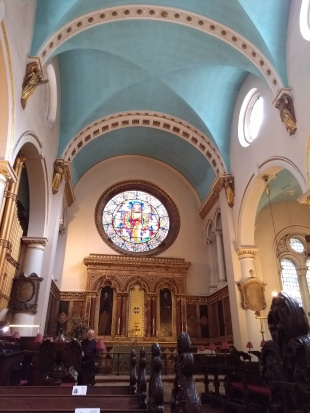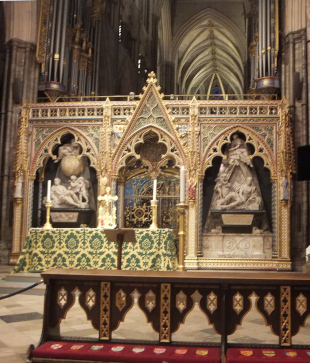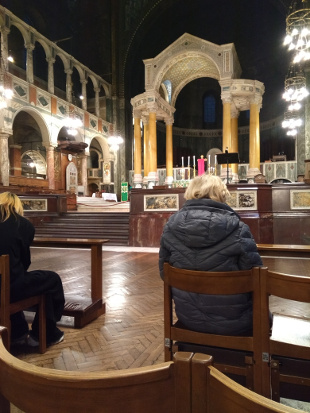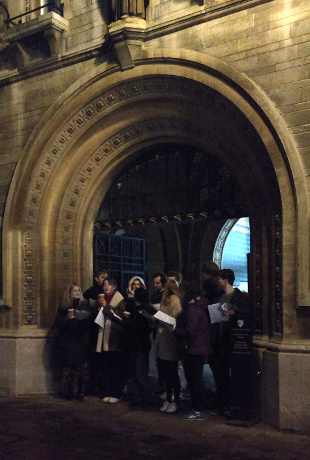

A global archive of independent reviews of everything happening from the beginning of the millennium
Read our Copyright Notice click here
For publication dates click here
There is a third star to this album and from the sound of it one could have listened all day to the sound reflections in this empty auditorium (since demolished).
At times listening to an organ recital I wonder if it might not be better to be a cat and to move around jumping up onto different pews and pulpits to listen from different places and to swivel ones' ears in the direction of the sound once having worked out where it is coming from.
Why Worry now we are back in lockdown, at the beginning of 2021, if all empty auditoria could sound as good?
Except that Covid-19 has made us accept the digital version of an analogue reality - people talk of having just met someone when they mean by video - and no cat would settle for that.
So it would seem better, when time allows, to let us back into one-fifth, one-tenth or one-hundredth full auditoria - and we can listen to the third star or for a mouse.
16 January 2021
So this is what is meant by the pulling out all the stops on the vaccination programme.
The Guardian has a swell story, Covid jabs to be accompanied by organ music at Salisbury Cathedral.
Overheard:
"No problems with registration but mixed up a syringe with a stop. Played at 3 weddings and 6000 vaccinations this month. New composition Fantasia and Fugue in Ow minor went well."
3 February 2021
So on the day Britain passed its 10 millionth vaccination which music would I recommend?
Well, I love these high notes on the organ.
You can hear them with E. Power Biggs playing Bach's Prelude and Fugue in G major, BWV 541 but I would go with the most recorded organist in the world, Marie-Claire Alain, playing the same from her third cycle of recording Bach's complete organ works.
Her tempo is so quick and regular and each high note can correspond to a jab so in each 7 minutes 9 seconds of playing you would get through quite a few and it's definitely upbeat.
21-22 September 2021


 The precincts of St Magnus
have the most spectacular views
The precincts of St Magnus
have the most spectacular views
 FDR, Grosvenor Square, 1948
FDR, Grosvenor Square, 1948
 A recent sculpture, Bond Street
A recent sculpture, Bond Street
SOUND REFLECTIONS
Reviewed by ANDRE BEAUMONT
We hear high and low pitched sounds all the time.
We had an earthquake in the Midlands in Britain in 2002 and, many safe miles away in the early hours, it felt and sounded like a skateboard going over a pock-marked pavement shaking buildings a little as it went. You heard it. The rumble of traffic may be ever present at low frequencies and you hear that, too.
High pitched sounds you hear all the time coming from electronics, electrical equipment and machinery and even landline telephone earpieces when they are securely in their cradle leading you to wonder which Wichita lineman has taken retirement in your area.
The very high pitched ones can be close to test tones in sound but what they definitely are not are musical notes.
So it can be a delight to find on recordings, which is the music we are largely confined to listening to during temporary lockdown, very high and low pitched musical notes that are sustained, preferably without falloff, as they are an obvious pleasant contrast to whines and rumbles.
For these the search can start with organ music.
2021 marks the 150th anniversary of the Royal Albert Hall
From the Royal College of Music
For comparison, the organ at the Royal Albert Hall has one pipe short of 10,000 (it is possible that a recital on that organ will take place in May) and the great organ at Methuen has over 6,500.
Michael Murray playing Bach's Fantasia and Fugue in G minor, BWV 542, on the latter organ has these delightful sustained high notes, especially in the fugue, that you do not hear in other recordings of the same work.
At the other end of the scale, for the low notes, Robert Ampt playing Boëllmann's Suite Gothique, especially the toccata, on the Hill organ in Sydney Town Hall with its 64 foot Contra-Trombone organ stop does the job though you might be just hearing the harmonics.
Royal College of Organists from the Albert Hall
*****
Cambridge in its monastic fastness just before Easter is a treat. Except that in the decades of tourism and global warming it has changed.
I remember once staying on a week into the Easter vacation as a student. Immediately the snow came down and blanketed the town already devoid of students and you got a great deal done in the friendly solitude of a College.
The lime avenue at Trinity a little after it was planted
Covid-19 has cleared what is now referred to as a city of people and few students have returned even though that has been permitted for practical subjects from 8 March 2021.
On 12 March 2021 I attended a virtual organ recital for the first time by watching the live stream of Anne Page [1] at Gonville & Cauis [2] and in that empty chapel with the side lit organ loft you get a flavour again of the monastic fastness.
It has to be said the playing, the execution, the lighting, the photography, the sound and the recording are all top notch and though no one much knows which frequencies theYouTube codec might compress away the bass notes are thrilling enough over headphones and there is sufficient of the acoustic of the chapel to invite a visit in person for some kind of reprise when we are allowed. It is good to see Gonville & Cauis on the organ recital circuit. Perhaps the smaller chapel than some of its neighbours suits it for streamed recitals.
*****
An adventure. Ten minutes at most to opportunistically visit a church.
The church of the Worshipful Company of Fishmongers.
Immediately fell in love with the tower. This is the real thing. Absolutely first class.
So the minutes will have to include the vantage points to snap from.
Sir Christopher Wren. Grade I listed; not a surprise.
This road is usually so busy that you get transported by without registering: this is St-Magnus-the-Martyr mentioned by T.S. Eliot.
The interior is intriguing so, good, turn round and there is a fine looking organ.
I look for something about the organ or a recital but no. Never mind, it is good to get in.
It is only later that the lines come back:
Where fishmen lounge at noon: where the walls
Of Magnus Martyr hold
Inexplicable splendour of Ionian white and gold
I will go back and do my own assessment of the interior but I have a problem. If Eliot was so affected by the interior I really ought to know for the purposes of Sound Reflections what it sounds like when the organ is playing!
There has been an organ for four centuries so I expect I will hear it one day. It was nearly noon, there were no fishmen (and you still cannot get a properly fresh herring in central London).
*****

There should be fish hereabouts and just down the hill is St-Magnus-the-Martyr
The bell summoning to midday mass that began to toll as I came out of the Underground sounded wonderful but especially glorious within St-Magnus-the-Martyr. The acoustic within is exceptionally good for the spoken voice of a celebrant, carrying readily anywhere but without muffling or echo.
With the City not so busy this September, a congregation in single figures, and it being, in all events, midday, I did not get to hear the organ play but I did get a feel of the Eliot experience.

The Grosvenor Chapel in Mayfair is the friendliest church in London to go to for an organ recital.

It is also on home territory; I worked for six years in the street parallel. A fair bit earlier, I had arrived on the other side of Oxford Street just as Eero Saarinen's American embassy chancery building (which is nearby) was being completed to spend much of my first decade.The mix of the rationality of both plentiful Georgian architecture and good, early modernist buildings was a significant formative experience; logic came visually even before school.

The Grade II listed building, much loved by admirers of the Georgian era, was, it would appear, designed by builder Benjamin Timbrell, who had worked for architect James Gibbs at St-Martin-in the-Fields, the design of which influenced this church.

Timbrell's design has had extensive reach, inspiring many churches in New England.
This is Ike's church and Florence Nightingale's, too.

Unfortunately, I find that plainly barrel-vaulted churches with generous depth of balcony rarely have exceptional acoustic for organ but the William Drake organ is in good order and Christopher Strange, a former organ scholar of the chapel, played an interesting programme of Handel, Robert Schumann and Nicholaus Bruhns very well.

St Michael's Cornhill is where the College of Organists (now Royal) was founded.
It has an organ that is well-voiced and in very good condition.

This is not an organ up in the gods. It is quite low down relative to the listener. The sound of the non-enclosed pipes comes at you directly and the enclosed ones give sound a short distance bounce off the nearby ceiling, mainly.
This must be good when you want to know exactly what the organist is playing and at once, as in an exam.
No time delay waiting for a note to bounce off a high vault and merge with other notes disguising inaccuracies .... or making something glorious.
There is a lot of stained glass and a lot of oculi so there is plenty of sound bouncing off glass, and ringing, and off plastered masonry, all of which to me is desirable. However, ultimately, the acoustic has limitations and can produce discordant sounds rather than the sophisticated melding of sound in a stone and glass environment like King's College Chapel.
I am not overly convinced of the attribution of the church to Wren. The top of the tower by Hawksmoor is a bonus.

Programme excerpt
Christopher Herrick reminds one why recorded organ music is still a world away from live.
The Bach had me studiously trying to compare the acoustic and organ to others but once into the Lemare, Buck and Guilmant I just settled into a feast of emotional provocations and engagement of the sonority and majesty of the organ, flawlessly executed.

I eventually got to hear the Foster & Andrews of Hull organ at All Saints Church, Cambridge at a recital by Christopher Moore.

As he explained it has not been restored since it was installed in 1864 so apart for an electric blower it is an authentically Victorian instrument. His programme was exclusively of Victorian era music written about the time of the construction of the Grade I listed church and the installation of the organ. The middle three pieces are by composers with very strong connections to Cambridge. It has two manual pedals and 18 speaking stops. Given its antiquity, it is a heavy and difficult organ to play, and the recital was executed with much skill and judgement.

It would be fair to say that the majority of a congregation will be hearing the organ as reflected sound though I positioned myself where I had a direct view of the organ and consequently could hear direct sound as well as reflected. It was a stimulating recital so located and nothing suggested that the acoustic would be anything other than fairly good anywhere else in the church.
I was mildly concerned it could have been a tad quiet with a full congregation in the past at the back of the church but changed my mind when at the back listening for voices at the front, after the recital.
As the organ has been moved since it was installed, presumably in modern times, it is very possible that there were once more copious direct sound paths, which I would prefer, but I was told G.F. Bodley, the architect, thought the organ too loud and he would have had much better opportunity to find out.
Just looking at the building's interior and listening, without music playing, here and there, I would say it has an appealing acoustic. For another organ recital, one day, I will sit near the back.

Westminster Abbey has Hawksmoor towers (from the clock upwards)
On 7 November 2021 I went to Peter Holder's recital of Widor's Symphony No.5 at Westminster Abbey.
I have no doubts about the organ's ability or placement for its function as accompaniment to services or to the great events of state.
To assess the acoustic there was one problem - the recital audience was seated in the outer nave not inner nave.

There would not have been the possibility of moving between one to the other. From memory the acoustic is more interesting the other side, with more recesses for sound to go into and be reflected from and more glass.
The reach of the smaller pipes I was a bit doubtful of but convinced fairly quickly by the thunderous bass. Peter Holder was clearly enjoying himself and when we reached the famous toccata the thunderclap potential of the organ was not in doubt. Be in the organ loft for too much of that and you would be losing your hearing. It hardly at all shakes the fabric so you do not hear through your chair or the floor as well. So it is louder than at King's but the method of hearing is different.

Westminster Cathedral
Westminster Cathedral is an intriguing, Byzantine-style structure finished just at the end of Victoria's reign and in places displaying an exquisite use of material. The recital was sandwiched between a rather grand evening vespers and a mass, both better attended than might be an Anglican equivalent.

After vespers but before the recital
Arriving at the end of vespers I positioned myself near the front where the acoustic for the choir was glorious.
The grand organ, however, was at the back and sound haD a long way to travel to the front and, indeed, upwards to the domed vaulting. The acoustic was good here, certainly pleasurable even if the ground floor ambulatories deadened reflected sound somewhat.

The organ is at the rear of a very large space, broad and long with the high domed ceiling kept in darkness like the night sky
So halfway through the recital, during a short pause, I moved two-thirds of the way back to where the sound could reach me quicker. Looking upwards it was too gloomy to see any pipes but delightfully the volume of sound was not that much greater there suggesting sound reflection paths were well distributed and that anyone seated in the nave for a service would hear plentiful but not deafening organ.
An attractive acoustic, all said, and all best brought out by the premiere of a composition by the organist, Ian Coleman, The boar dances, which constituted the finale of the recital. It seemed written to bring out the potential of the organ, which may have been so.
Since we are still in a phase of coronavirus, I must add that I was delighted with the way this large Victorian building provided ample natural ventilation everywhere, without draughts as might be the case with a Gothic church, and passively retaining heat so well without getting hot or cold in a cathedral that I have known since working in an office across the main road as a student architect.

Programme excerpt
On Friday 26 November 2021 I went to Gonville and Caius College for a recital by Colin Millington of English music, some of which sounded hard to play, with quite a bit of pedal work, and well-executed.

The Chapel is narrower than I anticipated and an intimate space so you are probably best off listening quite close to the organ as the sound is going to come at you directly anywhere and there is not much reflected sound in the scheme of things even by the window behind the altar.
The exception is off the ceiling but it took the Lennox Berkeley to bring this out as it uses more of the pipes.

You get a lot of vibration through the wooden pews and panelling and that is part of the route to hearing with organ music. I do not think elements of the architecture are resonating, though, as at King's.
I am nothing if not friendly at these events and they say curiosity killed the cat but as I was leaving part of the choir set up at the great gate and we have some more live music in this review: [3] [4].

At last a sound reflection in this review: they are good.